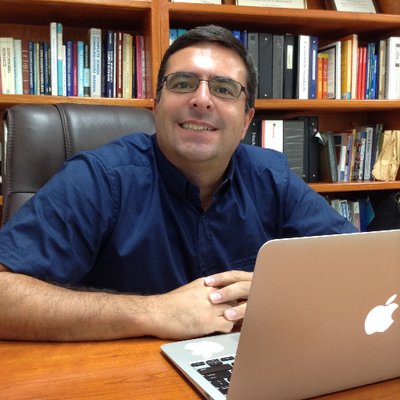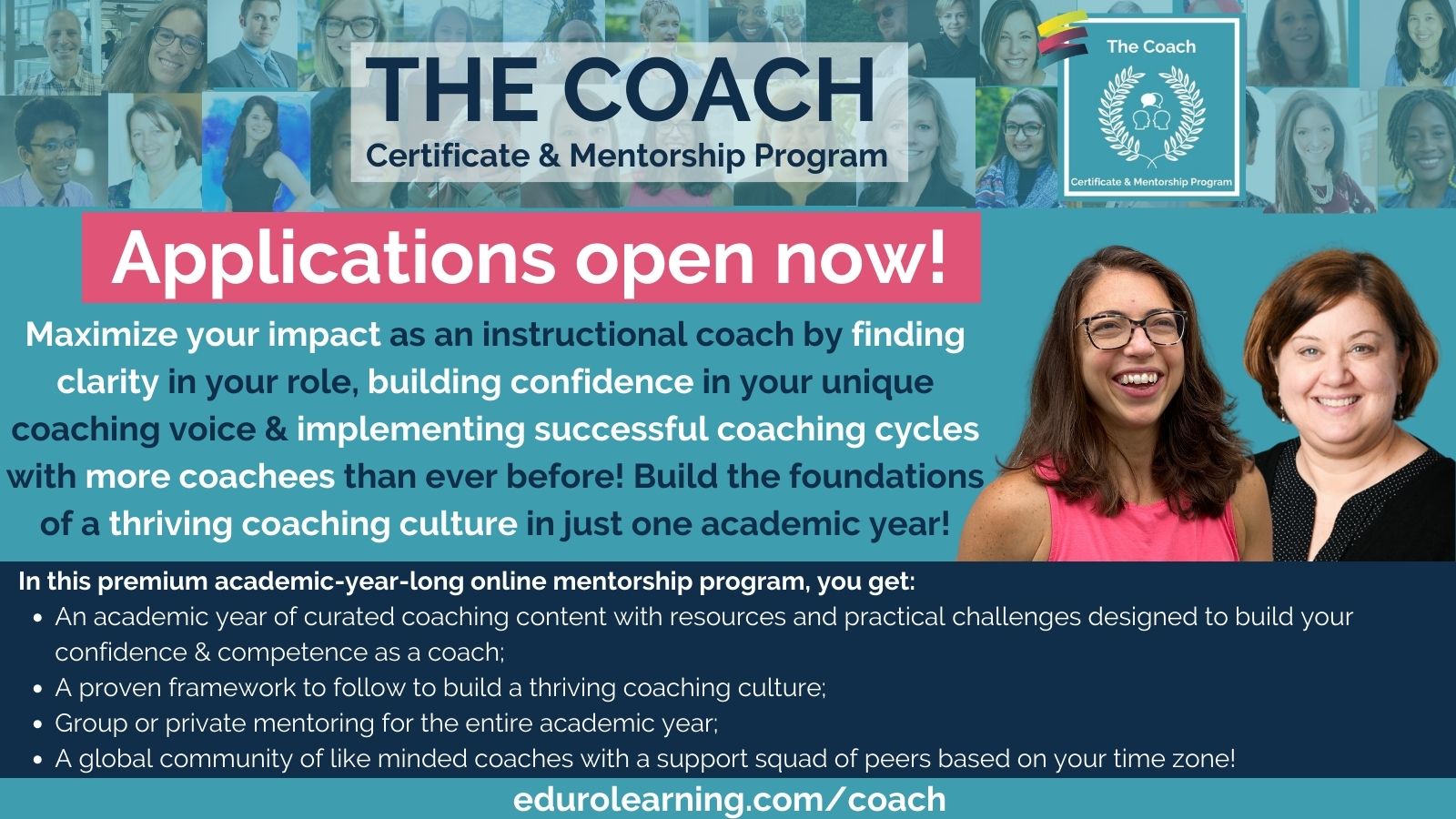In this #coachbetter episode, we have a thoughtful and in-depth conversation about innovation in schools with Tim, Tricia, Diana, Maggie, and Marcello from our YouTube series, Coaching Fundamentals. (Marcello sneaks in around the halfway mark so he didn’t get a formal introduction, but you’ll hear his voice in there!). Our conversation today focused on the Gartner Group’s model of the Hype Cycle and how it relates to implementing change in schools. We share some personal experiences with each stage of the cycle and then focus on strategies all instructional coaches can use to successfully implement new ideas in any school setting – so that change can be less stressful and much more manageable for teachers with very busy workloads!
Subscribe to #coachbetter via your favorite Podcast Player!
Featured Guests





Bonus! Watch the Spotlight Version on YouTube!
Show Notes
Article: Gartner Hype Cycle

Initial reactions
- Fits well with:
- Innovation Diffusion model (people at different stages: early adaptors to laggards)
- Micheal Fullan’s innovation dip
- Although these frameworks come from business, they relate to change in schools tools.
- A good reminder that teachers are on all sorts of carnival rides at the same time (roller coaster, merry go round, etc).
- Peter Senge: every school has two mindsets that it can choose to have: control or learning. School might have that mindset, but teachers might prefer the other (not necessarily a negative). Everyone needs a break at some point.
- Teachers can get caught up in innovation overload – don’t have time or mental space to adopt anything new right now.
Examples from our schools:
Tim: school jumped in with Nearpod. Watched the groundswell, everyone was using it, did PD, then there was a moment of “it’s not as great as we thought it was” and now only 4 teachers out of 60 use it.
Diana: intentional purchase of iPads and MacBooks. Apps were on fire, everyday people were downloading new apps. After 6 months – a year, it started to slow down. Some people started to question what was really needed, what was the purpose. Perspective changed to how are we using these devices for learning? Now it’s part of the regular teaching and learning, more authentic learning.
Maggie: Maker movement. Huge amount of resources were bought. Some people were skeptical about it being another bandwagon. Makerspaces were going to be small and distributed throughout the school (so accessible for students). STEAM Maker Saturdays: something that teachers didn’t have to do, because it was being offered on a Saturday, but could inspire teachers if they were interested. One summative assessment each year included a menu of choices with one option for a maker element that students could choose.
Managing Each Stage
Innovation Trigger to Peak of Inflated Expectations
At the beginning, most people will just need information. At this point, stay in a coaching role (don’t put people off by using a consultant role). Start with “what opportunities does this provide?”. As people move further, we can ask: “what might you think about changing?” As a coach, ask people to reflect on the kind of resources that are available to them, to make it personal and focused for them, so they can focus on the learning. Time is often a resource people neglect. To introduce something that’s completely new, takes a lot of time. “Where are you finding the time? What are you letting go of / going to say no to in order to make time for this?” There might be a few false starts, and provide an opportunity to reflect.
At the initial stages: make time for professional learning so that teachers are provided time to learn / explore / understand this new innovation before they’re expected to implement them. Time for pre-thinking or reading to make meetings more efficient. We expect teachers to pick up new ideas in less time than it actually takes.
Two connected thoughts:
- “If you don’t make time for something in the schedule, then you’re giving the subtle message that it’s not important.”
- “Your mark as a leader is not how many initiatives you started, but how many continue after you left”
Make sure it’s really clear how or why this initiative supports learning goals of the school and individual teachers. Can also use this as an opportunity to clarify the purpose of the tools and that it’s not going to be the end-all-be-all. More realistic expectations help make sure we don’t go so high up on the peak of expectations.
Different teachers have different strengths in different areas. Could manage the stages individually based on different strengths. Some people might need to be prepared differently for different stages. The exact same stage, at the same school, will look differently for different people.
Trough of Disillusionment:
You can make the come-down from the peak a little softer by changing the context. Everyone also does an activity or another pastoral care role. Let’s use this tool for an alternate purpose so people can see a different opportunity to use it. If teachers can see multiple uses for a tool, they may see more value in taking the time to learn how it works.
As coaches this is an important opportunity for us to support teachers who might struggle with new things. Opportunities to be reflective, to build steps, so that it not such a steep fall.
If the expectations are part of the teachers own practice, it’s more manageable than a large scale innovation (like iPads provided across school).
(Tricia)People who manage the trough best are the ones who are comfortable with tinkering and experimenting. The mindset of trial and error, and then reflection helps mitigate the drop down to the trough of disillusionment. Becomes more challenging when people don’t have time and space to take risks and learn from them.
Rely on collaborative teams to plan how they might implement new ideas. Mitigate the dip by allowing teachers to work together as they’re implementing new ideas – everyone will have a different approach.
Slope of Enlightenment:
sharing examples of successful implementation from different teachers. This could be early adopters (but doesn’t always have to be). Can provide the spark that another teacher needs.
Help teachers know that the plateau of productivity will come. It might not look like what you anticipate or planned, but that’s ok, there will be an evening out at the end.
Reflection is very important at this stage. Reminds Tricia of a video from RSA of Brene Brown’s The difference between compassion and sympathy.
This model helps us separate our personal connection to the innovation, to remind us that people’s feelings about change are not usually related to the individual who represents the change (even though it sometimes feels that way). Important for us to facilitate that conversation. This model can be the third item that we can point to – it’s not between two people. Getting out these feelings are important to the success of an institution. Conflict is an important part of growth. Usually problems with changes are because of forced innovation. Do not put every person on the same point on the map at the same time.
John Spencer: Tech adoption, related to feelings.
Time frame for innovation: be aware that there are key points in the school year when there are more stressful times that would NOT be a good opportunity to begin innovation. Just the timing could cause challenges and struggles that wouldn’t necessarily be there if you picked a different time of year.
This is at the very root of what we do as coaches: help people manage change. Everyone reacts to change differently. That’s what makes it hard. It’s easy to mismanage this journey too.
When we’re talking about innovation, it’s not just about the tool. What can we do to make different initiatives more sustainable? What can we do
How you manage each stage of the cycle:
- What does it mean in your context
- What does it look like / feel like?
- How do you support teachers? What works? What doesn’t?
- How do you know when you’re moving toward the next stage?
- Key coaching points in the year: I find May-June staff are suddenly Super keen again whilst Feb-March is the “danger zone.”
Level Up Your Coaching with The Coach!
If you are ready to dive deep into your coaching practice, to help you #coachbetter and build a thriving coaching culture in your school, please join us for our next cohort of The Coach!
Wherever you are in building a coaching culture in your school, The Coach will give you the strategies, skills and tools you need to make coaching a success and will empower you to confidently apply instructional coaching strategies in any situation – from building a coaching program, to having coaching conversations, to being a leader in your school community. We facilitate only one cohort each academic year so we can offer individualized support for each participant.
Coaches of all levels are welcome: you’ll start the program with a self-assessment to determine exactly what the next steps are for you!
Registration for our next global cohort opens once a year – check the website for details!

![Meet the Hype Cycle with Coaches Panel [Ep 56]](https://res.cloudinary.com/edurolearning/image/upload/v1565514056/coachbetter%20Podcast/coachbetter_spotlight_fullteam_ep56_jxanbb.jpg)




Recent Comments